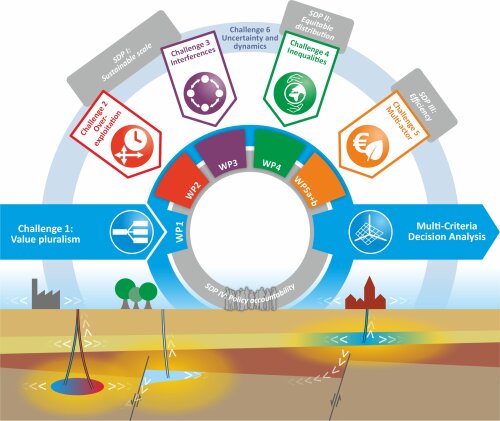Find out what we are working on in each work package

WP1: Integrative sustainability framework
Contact: Hannelore Peeters (hannelore.peeters2@uantwerpen.be), Tine Compernolle (tine.compernolle@uantwerpen.be) and Brent Bleys (brent.bleys@ugent.be)
WP1 creates a principles, criteria & indicators (PC&I) framework for the sustainability assessment of activities in the subsurface. This ecological economics framework will combine the geological, ecological, economic and social aspects of sustainability applied to different cases. Also participatory workshops with a variety of stakeholders and a two-round Delphi survey of national and international experts are held to capture a plurality of values. The goal of this WP is to come to a multi-criteria decision analysis (MCDA) to support authorities in governing the subsurface in a sustainable manner.
WP2: Sustainable production–no interference
Contact: Carolin Wallmeier (c.wallmeier@tudelft.nl) and Alex Daniilidis (A.Daniilidis@tudelft.nl)
WP2 develops the high-performance, physics-based modelling framework for identifying the most significant factors controlling subsurface resource use. Relevant applications include Heat Storage, gas storage, Direct Use Geothermal System and groundwater and will be modelled to establish their zone of influence without considering interaction with other activities as reference point. The focus is on long and very long-term behaviour (decades to centuries) and capacity of the subsurface resource at the basin level, with the possibility to include short term and small scale dynamic temporal changes (yearly to seasonal) in the production and development of subsurface activities. The final goal is to integrate the modelled activities into an overarching framework, that has the flexibility to expand or switch out individual activities, as well as to address uncertainties of the subsurface.
WP3: Sustainable scale–interference effects
Contact: Wouter Deleersnyder (wouter.deleersnyder@ugent.be), Luka Tas (luka.tas@ugent.be), Thomas Hermans (thomas.hermans@ugent.be)
One of the ultimate goals of DIAMONDS is to provide better policy insights regarding direct and cross-stratigraphic interference between different geological activities. The activities that are studied link to actual development options that are being discussed by industry and government, most of them at an early stage. Stakeholders expect realistic insights to evaluate the different development options, in a concrete but sufficiently generic and flexible context. In order to reach this goal, five selected activities are targeted: Direct Use Geothermal System, heat storage, gas storage, groundwater extraction and high-radioactive waste storage – the latter only included as a one-way receptor activity. Each of the activities lays in their own way a temporary or permanent claim on the subsurface (i.e. interaction and potential interference) and contribute differently to current and future well-being.
WP4: Environmental justice
Contact: Kyra Verbruggen (kyra.verbruggen@uantwerpen.be) and Anne Bergmans (anne.bergmans@uantwerpen.be)
WP4 studies dimensions of justice in the context of a sustainable development of the subsurface. The Campine Basin (situated in the north-east of Belgium) will be used as a case study to determine social indicators and impacts which are essential to consider for a just use of subsurface resources. This includes indicators related to participation, distribution of (social, economic, environmental) impacts, recognition of different values, justice for next generations, and more.
WP5a: Economic impact
Contact: Hanne Lamberts-Van Assche (hanne.lamberts-vanassche@uantwerpen.be) and Tine Compernolle (tine.compernolle@uantwerpen.be)
WP5a focuses on evaluating the economic impacts of various subsurface development scenarios in the Campine Basin, accounting for uncertainties that influence investment decisions and the interactions among different economic actors. As part of WP5a, a Real Options Game will be developed to address these complexities. The game will help assess how different subsurface activities—such as groundwater extraction and ATES systems—might interact and potentially affect each other's development.
WP5b: Environmental impact
Contact: Alexander Van Overmeiren (alexander.vanovermeiren@uantwerpen.be) and Matti Buyle (matthias.buyle@uantwerpen.be)
WP5b examines the environmental impact of subsurface activities, acknowledging the interconnection between the below ground geosystem and the above ground socio-economic and environmental system. WP5b starts with creating a causal loop diagram to reveal for different case studies the relationships within and between geological, economic, environmental and social subsystems. Relevant stakeholders provide input in this diagram. Secondly, system dynamics methods are used to quantify this model and estimate the adoption of different technologies. Thirdly, the model behaviour is enriched by adding aspects from agent-based modelling. Finally, life-cycle assessments of different technologies and their respective adoption rates make it possible to assess the environmental impact of the subsurface system in different scenarios.